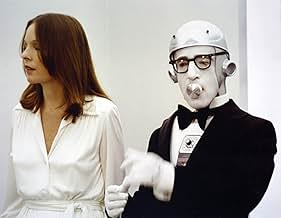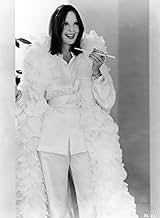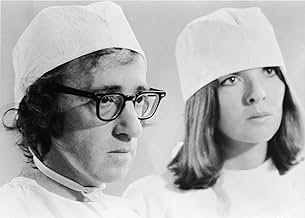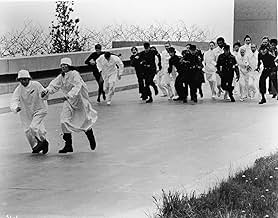CALIFICACIÓN DE IMDb
7.1/10
46 k
TU CALIFICACIÓN
El propietario de una tienda para frikis vuelve a la vida de la criostasis y se adentra en un mundo futurista para luchar contra un gobierno opresivo.El propietario de una tienda para frikis vuelve a la vida de la criostasis y se adentra en un mundo futurista para luchar contra un gobierno opresivo.El propietario de una tienda para frikis vuelve a la vida de la criostasis y se adentra en un mundo futurista para luchar contra un gobierno opresivo.
- Premios
- 2 premios ganados y 2 nominaciones en total
Mews Small
- Dr. Nero
- (as Marya Small)
Stanley Ralph Ross
- Sears Swiggles
- (as Stanley Ross)
John Cannon
- Various Voice-Overs
- (voz)
- (sin créditos)
Myron Cohen
- Robot Tailor
- (sin créditos)
- Dirección
- Guionistas
- Todo el elenco y el equipo
- Producción, taquilla y más en IMDbPro
Opiniones destacadas
In this early comedy, Woody Allen plays Miles Monroe, a twentieth century healthfood restaurant owner and jazz clarinettist who is cryogenically frozen after surgery and awoken two centuries later. The America of 2173 is a totalitarian state ruled by an oppressive dictator, and Miles has been reanimated by a group of rebels fighting to overthrow the government. For reasons too complex to set out here, Miles is forced to go on the run disguised as a robot and finds himself falling in love with his new owner, an attractive but intellectually vacant young woman named Luna. The film recounts how Miles wins Luna over to the rebel cause and tells the story of their fight against the regime.
Unlike some of Woody's later films, this is a pure comedy. It does not try to explore philosophical issues or to analyse the human condition in the same way as, say, "Hannah and her Sisters" or "Crimes and Misdemeanours". Although I normally think of Woody as a master of verbal wit, much of the humour in "Sleeper" is physical slapstick, based upon (and no doubt deliberate homage to) the comedians of the silent era such as Charlie Chaplin or Buster Keaton. (I particularly liked the scenes where Woody is disguised as a robot and those where the villains are attempting to clone the dictator, killed in a bomb explosion, from his nose). The links with that era are reinforced by the musical score, composed by Woody himself, in a jazz/ragtime style reminiscent of the 1910s and 1920s. The sets, by contrast, are very futuristic, with the clinical glass-and-chromium look of many science-fiction films. The combination of a futuristic theme with a traditional style of comedy is doubtless why the film was advertised under the slogan "Woody Allen takes a nostalgic look at the future".
This is not, however, simply a pastiche of silent humour like the one Mel Brooks was to attempt a few years later in "Silent Movie". This being a Woody Allen film, there is also a good deal of verbal humour, particularly one-liners along the lines of "I haven't seen my analyst in 200 years. He was a strict Freudian. If I'd been going all this time, I'd probably almost be cured by now". (As that line suggests, Miles is the typical, neurotically insecure Woody Allen character). As is often the case with humorous science-fiction (such as Douglas Adams's "Hitchhiker" books), the humour is frequently used to make satirical points about twentieth-century society as seen from the viewpoint of an imagined future. Contemporary worries about our diet are neatly satirised by a joke about how the science of two hundred years hence has proved that fatty foods and smoking are actually beneficial to health whereas what we now think of as healthfoods are regarded as unhealthy. This joke has remained topical because anxiety about what we eat is, if anything,even greater today than it was in 1973. There is perhaps also a dig at seventies "radical chic" as the vacuous conformist Luna becomes an equally vacuous revolutionary. (The plot of "Sleeper" seems to owe something to another tongue-in-cheek science-fiction film from a few years earlier, "Barbarella", which also dealt with rebellion against a dictator and even featured similar "orgasmatron" machines; the star of that film, Jane Fonda, had by 1973 become Hollywood's most famous radical chic actress).
The humour of "Sleeper" is often directed against figures from the sixties and seventies- perhaps too much so, as this type of humour tends to date very quickly. Some of it is still funny (such as Diane Keaton's Marlon Brando impersonation), but some can now be difficult to understand, particularly for non-Americans. (I had no idea, for example, who Howard Cosell was- apparently he was a sports commentator). That is, however, a minor quibble. Overall, this is an entertaining film and, in places, very funny, combining successfully two very different styles of humour. 7/10
Unlike some of Woody's later films, this is a pure comedy. It does not try to explore philosophical issues or to analyse the human condition in the same way as, say, "Hannah and her Sisters" or "Crimes and Misdemeanours". Although I normally think of Woody as a master of verbal wit, much of the humour in "Sleeper" is physical slapstick, based upon (and no doubt deliberate homage to) the comedians of the silent era such as Charlie Chaplin or Buster Keaton. (I particularly liked the scenes where Woody is disguised as a robot and those where the villains are attempting to clone the dictator, killed in a bomb explosion, from his nose). The links with that era are reinforced by the musical score, composed by Woody himself, in a jazz/ragtime style reminiscent of the 1910s and 1920s. The sets, by contrast, are very futuristic, with the clinical glass-and-chromium look of many science-fiction films. The combination of a futuristic theme with a traditional style of comedy is doubtless why the film was advertised under the slogan "Woody Allen takes a nostalgic look at the future".
This is not, however, simply a pastiche of silent humour like the one Mel Brooks was to attempt a few years later in "Silent Movie". This being a Woody Allen film, there is also a good deal of verbal humour, particularly one-liners along the lines of "I haven't seen my analyst in 200 years. He was a strict Freudian. If I'd been going all this time, I'd probably almost be cured by now". (As that line suggests, Miles is the typical, neurotically insecure Woody Allen character). As is often the case with humorous science-fiction (such as Douglas Adams's "Hitchhiker" books), the humour is frequently used to make satirical points about twentieth-century society as seen from the viewpoint of an imagined future. Contemporary worries about our diet are neatly satirised by a joke about how the science of two hundred years hence has proved that fatty foods and smoking are actually beneficial to health whereas what we now think of as healthfoods are regarded as unhealthy. This joke has remained topical because anxiety about what we eat is, if anything,even greater today than it was in 1973. There is perhaps also a dig at seventies "radical chic" as the vacuous conformist Luna becomes an equally vacuous revolutionary. (The plot of "Sleeper" seems to owe something to another tongue-in-cheek science-fiction film from a few years earlier, "Barbarella", which also dealt with rebellion against a dictator and even featured similar "orgasmatron" machines; the star of that film, Jane Fonda, had by 1973 become Hollywood's most famous radical chic actress).
The humour of "Sleeper" is often directed against figures from the sixties and seventies- perhaps too much so, as this type of humour tends to date very quickly. Some of it is still funny (such as Diane Keaton's Marlon Brando impersonation), but some can now be difficult to understand, particularly for non-Americans. (I had no idea, for example, who Howard Cosell was- apparently he was a sports commentator). That is, however, a minor quibble. Overall, this is an entertaining film and, in places, very funny, combining successfully two very different styles of humour. 7/10
Woody Allen's films are generally treasured among other comedies because of their wit and charm. Many critics would agree, though, that Allen's earlier films were among his best. One of those movies was a lighthearted film called `Sleeper,' which starred a younger version of Allen and a younger, but always beautiful Diane Keaton. Although `Sleeper' leaves a person in stitches from laughter, its one flaw is that it lacks an ending. But don't let that stop you from seeing this comedy classic. In the end, who cares where it goes because it's just flat out funny. `Sleeper' is the story of Miles Monroe (Allen), who is cryogenically frozen in 1973 after having a procedure in a hospital. He is awoken nearly 200 years later by a group of scientists who want Monroe to help them defeat the leader of their society, as America's future consists of a totalitarian state. While on his adventure through this futuristic world, Monroe meets a beautiful woman named Luna Schlosser (Keaton) who he begins to have a love interest in. The two team up to try to oust their tyrannical government and bring about freedom and prosperity. `Sleeper' was hysterical from beginning to end. The very opening scene shows Monroe covered in tin foil-clearly scientists in 1973 found new and amazing uses for this wonderful kitchen product. As soon as Monroe awakens, he is disoriented, smiling aimlessly into space and walking backwards and into people. Allen's comical blend of intellect and charm shows up soon after. The futuristic society is comprised of people who have no historical references for the events of the past 200 years, as their leader has undoubtedly outlawed certain forms of knowledge that could lead to rebellion. They use Monroe to fill in the historical gaps by showing him pictures of famous twentieth century individuals, such as Joseph Stalin. Monroe provides his own synopsis of their contributions to the world in his own clever way, as he does also for former President Nixon. Allen's writing, direction and performance were hilarious. Rarely do we see writing as clever and sidesplitting in today's comedies. The only other comic director today that could even compare to Allen would be Christopher Guest, whose mockumentary films such as `Best In Show,' and the recent `A Mighty Wind,' have a real source of comedy. Most present comedies are trivial, filled with rehashed jokes that depend more on toilet humor than any form of real wittiness. The film's only problem is that after an hour and a half, it doesn't seem to know what to do with itself. It ends on a clever note about love with the protagonists somehow managing to save themselves, but not really the day. They realize that perhaps the only thing worth fighting for, in the end is love. All in all, `Sleeper' was a very funny farce on science fiction stories, and it cemented Allen's ability to be an engaging and funny in his films. ***
I think I am going to have to rank this as Woody Allen's second-best (and second-funniest) movie... after the unbeatable "Annie Hall". Even after having seen the movie 3 or 4 times I still find myself amused by some of Allen's shtick... and his rarely-demonstrated adeptness at physical comedy. So many classic physical bits: riding around in the wheelchair... eating the rubber glove... the future scientists trying to force his slack body into a futuristic vehicle. After this movie Woody started to get a little too cerebral... this was his last attempt at a just-plain-funny movie... and probably his most satisfying of his early comedies... only because there was a sort-of storyline. Woody is cryogenically frozen after a botched operation in the 1970s and is awoken 200 years later to find himself in a repressive Orwellian future. He meets up with a spoiled rich chick (Diane Keaton) and influences her (not really intentionally) into becoming a revolutionary activist.
We are blessed that Woody was around, making movies as interesting as this when he was.
Already with this one, he began his vast exploration of movie techniques and devices that would last 25 years or so.
The idea is simple in this one: he wanted to use film slapstick from a bygone era. How better to situate that than to move the whole picture into a future era?
We have some truly classic stuff here. The banana joke, The mirror joke. The robot pantomime. The acting out of the Jewish dinner (done in later movies too). The inflated man joke. You can find all these in any number of Keaton. Marx, Laurel & Hardy movies.
The unifying string of time travel, a romance, the leader and his nose is too weak to make this a solidly recommended outing. And it wouldn't be for a couple years until Woody cared about the cinematography at all.
I had forgotten how pretty Diane Keaton was. Very.
Ted's Evaluation -- 2 of 3: Has some interesting elements.
Already with this one, he began his vast exploration of movie techniques and devices that would last 25 years or so.
The idea is simple in this one: he wanted to use film slapstick from a bygone era. How better to situate that than to move the whole picture into a future era?
We have some truly classic stuff here. The banana joke, The mirror joke. The robot pantomime. The acting out of the Jewish dinner (done in later movies too). The inflated man joke. You can find all these in any number of Keaton. Marx, Laurel & Hardy movies.
The unifying string of time travel, a romance, the leader and his nose is too weak to make this a solidly recommended outing. And it wouldn't be for a couple years until Woody cared about the cinematography at all.
I had forgotten how pretty Diane Keaton was. Very.
Ted's Evaluation -- 2 of 3: Has some interesting elements.
Miles Monroe (director Allen), a health food store owner and jazz clarinetist, goes to a hospital for a routine operation, but something goes wrong and he is put to cryogenic sleep for over 200 years. When he is woken up in the 22nd century, the society has changed into a pleasure-addicted dictatorship. Miles is immediately pulled into revolutionary activity and soon has to flee the state police on his way to the mysterious ruler of the society. He also finds himself teaming up with an initially reluctant woman called Luna (Diane Keaton) and together they adventure through the futuristic society.
The comedic style of Sleeper is an entertaining combination of over-the-top farce and Allen's usual verbal jabs at the society of the 20th century. The silly jazz music accompanying the bumbling chase scenes evokes memories from the silent era (some scenes are even sped-up), and the old masters of slapstick have clearly been a major influence to the style. There are also many references to more modern works of science fiction, such as 2001: A Space Odyssey and Nineteen Eight-Four. Besides the funny farcical scenes, Allen gets to perform his classic neurotic worrying routine that works fine and will amuse fans of his on-screen persona.
A very notable aspect of the film is its visual style: the sets and props all look excellent. The futuristic houses, round vehicles, stiff servant robots, gigantic fruits and even an unruly pudding look hilarious and the many details of the society provide chances to comment on how things are advancing in our times. Be it an orgasm-machine or nonsensical poetry, they seem to suggest we are moving towards times where ignorance revels and empty pleasure-hunting is celebrated as the only correct form of bliss; it can be said that the underlying themes of Sleeper are not unlike those of Aldous Huxley's classic novel Brave New World.
Social commentary aside, Sleeper is also a very funny comedy that appeals not only to friends of Allen's neurotic shtick but also to slapstick fans and admirers of creative production design. Diane Keaton also deserves praise for her performance that features all the necessary comical energy and makes a good pairing for the protagonist Miles. In brief, I laughed out loud several times and would rank the film highly among the handful of Allen films I've seen so far. As far as sci-fi comedies go, Sleeper is a definite winner.
The comedic style of Sleeper is an entertaining combination of over-the-top farce and Allen's usual verbal jabs at the society of the 20th century. The silly jazz music accompanying the bumbling chase scenes evokes memories from the silent era (some scenes are even sped-up), and the old masters of slapstick have clearly been a major influence to the style. There are also many references to more modern works of science fiction, such as 2001: A Space Odyssey and Nineteen Eight-Four. Besides the funny farcical scenes, Allen gets to perform his classic neurotic worrying routine that works fine and will amuse fans of his on-screen persona.
A very notable aspect of the film is its visual style: the sets and props all look excellent. The futuristic houses, round vehicles, stiff servant robots, gigantic fruits and even an unruly pudding look hilarious and the many details of the society provide chances to comment on how things are advancing in our times. Be it an orgasm-machine or nonsensical poetry, they seem to suggest we are moving towards times where ignorance revels and empty pleasure-hunting is celebrated as the only correct form of bliss; it can be said that the underlying themes of Sleeper are not unlike those of Aldous Huxley's classic novel Brave New World.
Social commentary aside, Sleeper is also a very funny comedy that appeals not only to friends of Allen's neurotic shtick but also to slapstick fans and admirers of creative production design. Diane Keaton also deserves praise for her performance that features all the necessary comical energy and makes a good pairing for the protagonist Miles. In brief, I laughed out loud several times and would rank the film highly among the handful of Allen films I've seen so far. As far as sci-fi comedies go, Sleeper is a definite winner.
¿Sabías que…?
- TriviaWoody Allen originally intended the film to be three hours long and in two parts. The first part would have him in the present day, coping with life until his illness. And the second half would be the futuristic part. But United Artists rejected this concept.
- ErroresLuna's shoes change from high heels to flats when she crosses the lake on Miles' back (in the "raft" costume).
- Citas
Luna Schlosser: It's hard to believe that you haven't had sex for 200 years.
Miles Monroe: 204, if you count my marriage.
- ConexionesEdited into Intimate Portrait: Diane Keaton (2001)
- Bandas sonorasTill We Meet Again
(1918) (uncredited)
Music by Richard A. Whiting
Lyrics by Ray Egan
Performed by Woody Allen
Selecciones populares
Inicia sesión para calificar y agrega a la lista de videos para obtener recomendaciones personalizadas
- How long is Sleeper?Con tecnología de Alexa
Detalles
- Fecha de lanzamiento
- País de origen
- Idiomas
- También se conoce como
- Sleeper
- Locaciones de filmación
- Sculptured House - 24501 Ski Hill Drive, Golden, Colorado, Estados Unidos(mushroom shaped building, top of mountain on south side of I-70)
- Productoras
- Ver más créditos de la compañía en IMDbPro
Taquilla
- Presupuesto
- USD 2,000,000 (estimado)
- Total en EE. UU. y Canadá
- USD 18,344,729
- Total a nivel mundial
- USD 18,344,868
Contribuir a esta página
Sugiere una edición o agrega el contenido que falta

Principales brechas de datos
By what name was El dormilón (1973) officially released in India in English?
Responda





















